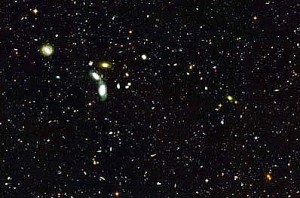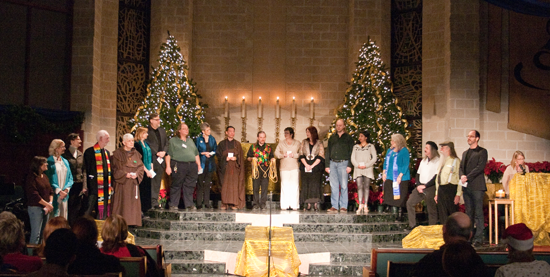Amy at Texas Faith: Rise of the Nones
Q: What is it that the institutions of religion are not providing a growing number of people? And if this younger generation remains unaffiliated as it ages, what’s the future of religion?
AMY MARTIN, Executive Director, Earth Rhythms; Writer/Editor, Moonlady Media
Sometimes an image changes everything. The early NASA views of Earth from the Moon, the first times we were able to see the planet as a whole, a fragile blue sphere in a sea of infinite space, sparked both an environmental movement and a sense of global citizenry—anathema to national and religious separatism.
For this current sea change in religion it is the Hubble Deep Field Photograph. It looks like a typical starry sky, but the thousands of light points are not stars, but galaxies and star clusters, no doubt home to other conscious life. The Nones ask: Where do our Earth-based religious narratives fit in all that?
We are in a period of universalizing, where the truths we have here must be compatible with the cosmos out there. The spiritual-not-religious movement is far more than people turning away from quarreling, politics-infested religions that vie for the sole possession of truth. This movement instead seeks a faith that can take us into the 21st century and beyond to the furthest galaxy.
 The future of religion is like the future of anything else: change. The current religious arrangement cannot be seen as the apex of spiritual thought, the cap of some kind of spiritual ascendency that must be maintained. The Nones reject that entirely. Instead they see human and spiritual development as a continually unfolding process.
The future of religion is like the future of anything else: change. The current religious arrangement cannot be seen as the apex of spiritual thought, the cap of some kind of spiritual ascendency that must be maintained. The Nones reject that entirely. Instead they see human and spiritual development as a continually unfolding process.
The spiritually unaffiliated ask us to let go of religious ego and the need to possess and control, to release literalism and the need defend. Because all that is local and transitory against cosmic time. Instead, they ask us to dig deeper and reveal the truth of all these faiths, to uncover the core that is universal.
Ultimately, Nones are comfortable with ambiguity and humble enough to accept that they will never have all the answers, seeing any religion as the penultimate solution to the mystery of our existence. By bringing to the fore our highest common denominators, it will be the Nones that lead us to world peace, and nothing is more optimistic for the future of religion than that.
NOTES
The number of Americans who do not identify with any religion is growing at a rapid pace. One-fifth of the U.S. public – and a third of adults under 30 –are religiously unaffiliated today, the highest percentages ever in polling by the Pew Research Center. In the last five years alone, the unaffiliated have increased from just over 15% to just under 20% of all U.S. adults. They include self-described atheists and agnostics but increasingly people who say they are spiritual but have no particular religious affiliation. This large and growing group of Americans is less religious than the public at large on many conventional measures, including frequency of attendance at religious services and the degree of importance they attach to religion in their lives.
With few exceptions, they say they are not looking for a religion that would be right for them. Overwhelmingly, they think that religious organizations are too concerned with money and power, too focused on rules and too involved in politics. The growth in the number of religiously unaffiliated Americans – sometimes called the rise of the “nones” –is largely driven by generational replacement, the gradual supplanting of older generations by newer ones.

1 comment
I keep a large book of Hubble photos on my coffee table. Great answer!
Comments are closed.